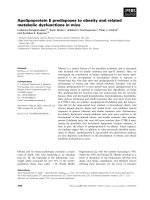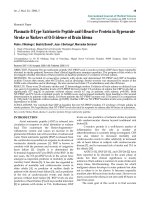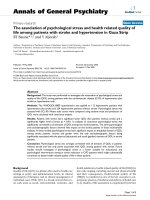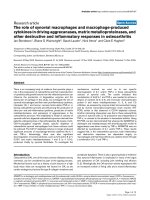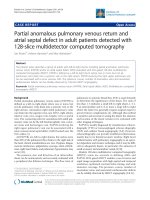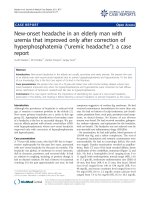Báo cáo y học: "Vertebral hyperostosis, ankylosed vertebral fracture and atlantoaxial rotatory subluxation in an elderly patient with" ppsx
Bạn đang xem bản rút gọn của tài liệu. Xem và tải ngay bản đầy đủ của tài liệu tại đây (313.37 KB, 4 trang )
BioMed Central
Page 1 of 4
(page number not for citation purposes)
Journal of Medical Case Reports
Open Access
Case report
Vertebral hyperostosis, ankylosed vertebral fracture and
atlantoaxial rotatory subluxation in an elderly patient with a history
of infantile idiopathic scoliosis; a case report
Ali Al Kaissi*
1,2
, Elisabeth Zwettler
1
, Katharina M Roetzer
1
, Joerg Haller
1
,
Franz Varga
1
, Klaus Klaushofer
1
and Franz Grill
2
Address:
1
Ludwig Boltzmann Institute of Osteology at the Hanusch Hospital of WGKK and AUVA Trauma Centre Meidling, 4th Medical
Department, Hanusch Hospital, Vienna, Austria and
2
Orthopaedic Hospital of Speising, Vienna, Austria
Email: Ali Al Kaissi* - ; Elisabeth Zwettler - ;
Katharina M Roetzer - katharina.rö; Joerg Haller - ; Franz Varga - ;
Klaus Klaushofer - ; Franz Grill -
* Corresponding author
Abstract
This is a case report of a 48-year-old-woman with scoliosis since early childhood. Recent
radiographic spinal assessment revealed the presence of distinctive spinal abnormalities. To the
best of our knowledge this is the first clinical report describing a constellation of unusual changes
in an elderly woman with a history of infantile idiopathic scoliosis.
Case presentation
Forestier and Rotes-Querol first described the disease Dif-
fuse Idiopathic Skeletal Hyperostosis (DISH) in 1950 [1].
These authors provided a precise description, separating
the disease from discoarthrosis and ankylosing spondyli-
tis. Resnick and Niwayama [2] described the diffuse
nature of the disease and proposed widely used diagnostic
criteria. The disease is usually seen in male patients over
45 years of age and characterised by new bone formation
at the entheses. Diagnostic criteria of DISH include flow-
ing ossification along at least 4 contiguous vertebrae, pres-
ervation of disk spaces, absence of vacuum phenomena or
vertebral body marginal sclerosis, and absence of apophy-
seal joint ankylosis or sacroiliac joint erosions or fusion.
The thoracic spine is most commonly involved, but radi-
ographic findings in both the spine and extraspinal struc-
tures suggest a generalised disorder of ossification rather
than a localised spinal disease. While Diffuse Idiopathic
Skeletal Hyperostosis (DISH) is mostly asymptomatic, it
can predispose the patient to catastrophic complications.
The common potential complications of DISH in the cer-
vical and thoracic spine include fractures, dysphagia, cer-
vical and/or thoracic myelopathy, paraplegia, and dens
spinal cord injury resulting from even minor trauma [1-
6].
On the other hand the classical risk factors for DISH are
known to co-exist in the following conditions; diabetes
mellitus type 2, obesity, and hyperuricaemia [6]. Previous
reports describing DISH patients with spinal fractures are
rare [3-5]. Scoliosis is seemingly not listed among the
major risk factors for the development of DISH. The pur-
pose of this case report is to characterise and consider
whether idiopathic infantile scoliosis represents an addi-
tional risk factor for the development of spinal hyperosto-
sis in elderly people
Published: 6 June 2007
Journal of Medical Case Reports 2007, 1:25 doi:10.1186/1752-1947-1-25
Received: 31 January 2007
Accepted: 6 June 2007
This article is available from: />© 2007 Al Kaissi et al; licensee BioMed Central Ltd.
This is an Open Access article distributed under the terms of the Creative Commons Attribution License ( />),
which permits unrestricted use, distribution, and reproduction in any medium, provided the original work is properly cited.
Journal of Medical Case Reports 2007, 1:25 />Page 2 of 4
(page number not for citation purposes)
The patient has a history of idiopathic infantile scoliosis.
Her scoliosis was treated at the age of 9 years by bracing
technique only. Apparently, the nature of her scoliosis
was progressive; her Cobb's angle was 64°. The patient
was recently identified as having spinal osteoporosis. The
periodic clinical and radiographic assessment revealed the
diagnosis of diffuse idiopathic skeletal hyperostosis (fig 1,
2)
She was married and her gestational history revealed five
pregnancies (two spontaneous abortions in the first tri-
mester and another two ectopic pregnancies, the reason
behind these events were not identified). She had one
normal male offspring.
Clinical examination revealed normal phenotype, thin
woman with significant thoracic kyphoscoliosis. Passive
rotation of the neck was associated with moderate pain.
There was mild torticollis (fig 3). Tenderness along the
cervical area was noted. Similarly point tenderness over
the upper thoracic spine was notable (fig 1). A neurologic
examination included testing muscle strength, sensation
and reflexes of the lower extremities. Bowel and bladder
sphincter control were all within normal limits. No com-
plaint of pain in her pelvis. Examining the rest of her
joints revealed nothing of significance. Her height, weight
and head circumference were normal. Abdominal and
renal ultrasound was normal.
Recently, she was identified, as being affected with spinal
osteoporosis through the national screening programme.
Central (DXA) showed that lumbar spine, T -Score -3.1 SD
(osteoporosis), whereas the femoral neck T-Score -1.7 SD
(osteopenia). Blood sugar and uric acid levels were nor-
mal. Biochemical tests showed mild elevations of serum
calcium 2.74 (2.20–265 mmol/l), ionised calcium 1.63
(1.18–1.30 mmol/l), β-crosslaps 1.170 (normal for post-
menopausal women is 0.400–1.008 ng/ml).
Coronal computerised tomographic reconstructions demon-strating asymmetric lateral atlantodental intervals because of rotation at C1-C2Figure 3
Coronal computerised tomographic reconstructions demon-
strating asymmetric lateral atlantodental intervals because of
rotation at C1-C2. Note C2 in the coronal position with the
anterior arch of C1 markedly overlying the right facet result-
ing in AARS and the existence of two fractures; a) healed
fracture of the right anterior arch of atlas and b) another
healed fracture of the lateral right process of C2.
Ankylosed spine fractures in lateral radiogram of the thoracic vertebrae, arrows showed sawtooth aspect fracturesFigure 1
Ankylosed spine fractures in lateral radiogram of the thoracic
vertebrae, arrows showed sawtooth aspect fractures.
Sagittal MRI shows progressive simultaneous ossification of the anterior longitudinal and the posterior longitudinal spinal ligaments respectively and the apparent ankylosed spine frac-ture (arrow)Figure 2
Sagittal MRI shows progressive simultaneous ossification of
the anterior longitudinal and the posterior longitudinal spinal
ligaments respectively and the apparent ankylosed spine frac-
ture (arrow).
Journal of Medical Case Reports 2007, 1:25 />Page 3 of 4
(page number not for citation purposes)
Diffuse idiopathic skeletal hyperostosis (DISH) is an ossi-
fying, non-inflammatory, non-erosive enthesopathy
favouring the dorsal spine but sparing the sacroiliac
joints. DISH affects 3–6% of the population over 40 years
of age and 11% aged over 70 years [1-4]. A varying propor-
tion of patients with DISH have ossification of the poste-
rior longitudinal ligaments.
DISH leads to acquired narrowing of the spinal canal due
to the presence of osteophytes, which sometimes create
bony hooks within the spinal canal [1-6]. The cause and
pathogenesis of DISH are still unknown. Kiss et al., [5]
studied the risk factors and the radiographic features of
131(69 males and 62 females) affected with DISH. Obes-
ity, diabetes mellitus, smoking, and hypertension were
shown to be the most likely predisposing factors. Some
authors have noted the occasional familial incidence of
DISH, leading to a suspicion of genetic predisposition [6]
De Peretti et al [4], described 48 fractures in 48 patients
over a period of 17 years. Twenty patients (mean age 62
years) had ankylosing spondylitis and 28 patients (mean
age 81 years) had DISH syndrome. They concluded that
spinal fractures in patients with DISH syndrome generally
occur spontaneously or after low-energy trauma. None of
the reported patients showed a history of scoliosis. They
identified 4 types of spine fractures in their series. Our
patient manifested type II fracture of the de Peretti et al,
classification.
Previous studies have indicated a significant correlation of
osteoporosis with idiopathic scoliosis in adults. Cheng
and Guo [7] supported the hypothesis that adolescents
with idiopathic scoliosis are at increased risk of oste-
oporosis compared to the general paediatric population.
None of these reports signified the correlation between
idiopathic infantile scoliosis and the development of
DISH later in life.
Our patient illustrated lateral displacement of the dens by
more than 4 mm, the latter was suggestive of atlanto-axial
rotatory subluxation (AARS) [8]. The computerised tomo-
gram of the atlanto-axial region demonstrated asymmetri-
cal odontoid-lateral mass distance and confirmed the
existence of two healed fractures. It is suggested that the
persistence of abnormal dynamics, secondary to the delay
in treating AARS, can lead to the development of patho-
logical stickiness between the atlas and the axis, probably
because of contractures of peri-articular soft tissue [8,9].
Evidence supports, that conservative treatment in the eld-
erly population can be managed non-operatively, because
few demands are made on the neck. In young adults the
story is different. The use of early cranial traction followed
by external immobilisation for six weeks is a usual proce-
dure to achieve good long-term stability. If recurrent or
irreducible subluxation developed, open reduction and
posterior atlantoaxial fusion may be required [10]
Osteoporotic vertebral compression fractures are a major
cause of morbidity and health care cost among elderly
patients. In the past, the primary therapy for these frac-
tures has been conservative. Percutaneous vertebroplasty
is now a therapeutic option for individuals where medical
management has not been successful or for those at risk of
developing complications due to long-term immobiliza-
tion. On the other hand, injectable biomaterials may
decrease the incidence of new vertebral fracture e.g. cal-
cium phosphate has been introduced to relieve pain and
at the same time is capable of integrating into the bony
matrix [11]
Conclusion
In the light of our findings, we believe that the degree of
osteoporosis of the adjacent vertebral bodies, the develop-
ment of ankylosed spinal hyperostosis, fractures and
AARS are a constellation of abnormalities developed in
connection with the early onset of idiopathic infantile
scoliosis. DISH patients are usually reported to have a his-
tory of diabetes mellitus, obesity, and hyperuricaemia. We
wish to stress, that scoliosis might be a possible con-
founder in the relationship between spinal osteoporosis
and the development of spinal hyperostosis in the elderly.
Further studies are needed to elucidate this sort of correla-
tion.
Abbreviations
(DISH) diffuse idiopathic skeletal hyperostosis; (AARS)
Atlantoaxial rotatory subluxation; (AAS) atlanto axial sub-
luxation.
Competing interests
The author(s) declare that they have no competing inter-
ests.
Authors' contributions
All authors read and approved the final manuscript and
all participate in this work.
Acknowledgements
We thank Dr. A Z Al-Bahrani Specialist Registrar, Department of Surgery.
Hemel Hempstead General Hospital, UK for his technical help. And we
thank the patient for cooperation and consent for publishing the data.
References
1. Forestier J, Rotes-Querol J: Senile ankylosing hyperostosis of
the spine. Ann Rheum Dis 1950, 9:321-30.
2. Resnick D, Shaul RS, Robins JM: Diffuse idiopathic skeletal hyper-
ostosis (DISH): Forestier's disease with extraspinal manifes-
tations. Radiology 1975, 115:13-24.
3. Paley D, Schwartz M, Cooper P, Harris WR, Levine AM: Fractures
of the spine in diffuse idiopathic skeletal hyperostosis. Clin
Orthop Relat Res 1991, 267:22-32.
Publish with BioMed Central and every
scientist can read your work free of charge
"BioMed Central will be the most significant development for
disseminating the results of biomedical research in our lifetime."
Sir Paul Nurse, Cancer Research UK
Your research papers will be:
available free of charge to the entire biomedical community
peer reviewed and published immediately upon acceptance
cited in PubMed and archived on PubMed Central
yours — you keep the copyright
Submit your manuscript here:
/>BioMedcentral
Journal of Medical Case Reports 2007, 1:25 />Page 4 of 4
(page number not for citation purposes)
4. de Peretti, Sane JC, Drane G, Razafindrotsiva C, Argenson C: Anky-
losed spine fractures with spondylitis or diffuse idiopathic
skeletal hyperostosis: diagnosis and complications. Rev Chir
Orthop Reparatrice Appar Mot 2004, 90(5):456-65.
5. Kiss C, Szilagy MM, Pasky A, Poor G: Risk factors for diffuse idio-
pathic skeletal hyperostosis: a case-control study. Rheumatol-
ogy 2002, 41:27-30.
6. Hamanishi C, Tan A, Yamane T, Tomihara M, Fukuda K, Tanaka S:
Ossification of the posterior longitudinal ligament. Auto-
somal trait. Spine 1995, 20:205-207.
7. Cheng JCY, Guo X: Osteopenia in adolescent idiopathic scolio-
sis, a primary problem or secondary to the spinal deformity?
Spine 1997, 22:1716-1721.
8. Oostveen JC, Van de Laar MA, Tuynman FH: Anterior atlantoaxial
subluxation in a patient with diffuse idiopathic skeletal
hyperostosis. J Rheumatol 1996, 23(8):1441-4.
9. Papadopoulos SM, Dickman CA, Sonntag VK, Rekate HL, Spetzler RF:
Traumatic atlantooccipital dislocation with survival. Neuro-
surgery 1991, 28:574-579.
10. Fielding JW, Hawkins RJ: Atlanto-axial rotatory fixation (fixed
rotatory subluxation of the atlanto-axial joint). J Bone Joint Surg
Am 1977, 59:37-44.
11. Hardouin P, Grados F, Cotton A, Cortet B: Should Percutaneous
vertebroplasty be used to treat osteoporotic fractures? An
update. Joint Bone Spine 2001, 68:216-221.
